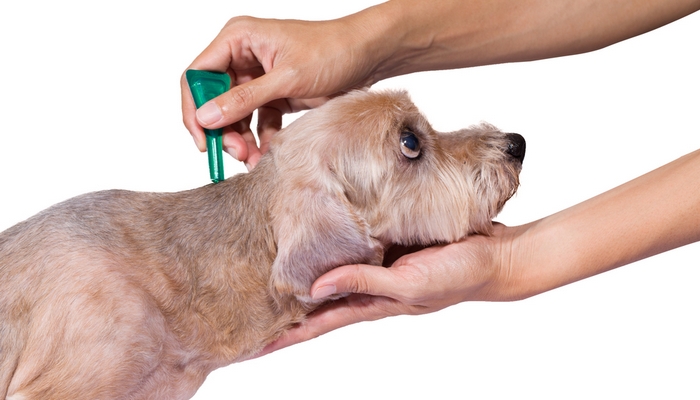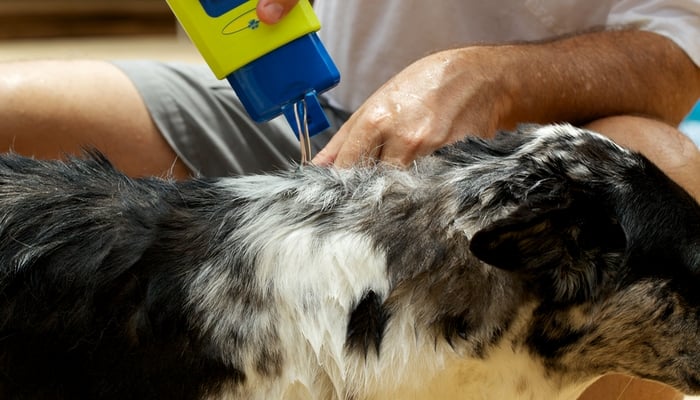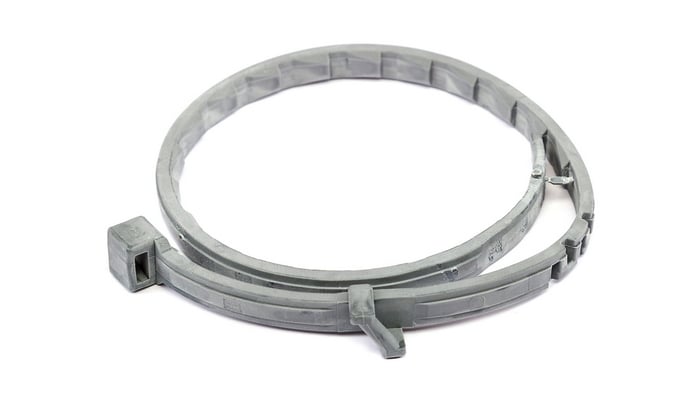Fleas are not just a nuisance to dogs and their owners, they also pose a significant health problem. Fleas carry a wide range of diseases which are dangerous to both dogs and their owners, some of which can be fatal! Learning about preventing fleas on dogs is necessary for every pet owner.
Take it from someone with experience – it's much easier to prevent fleas from getting on your dog than it is to get rid of the little buggers once they've infested your pet. An infestation of fleas on a dog can lead to secondary skin infections, tapeworms, flea allergy dermatitis or even anemia.
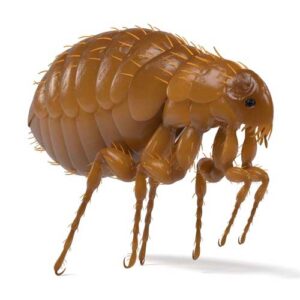
There are many different types of flea preventatives to choose from, including topical flea treatments, oral dog flea pills, sprays, dog flea collars and powder treatments. Before you decide on a method for preventing fleas on dogs, be sure to chat with your veterinarian.
Not all dog flea preventatives are created equally, and your veterinarian will be able to explain the pros and cons of each of your options.
Some flea treatments aren't safe, although contrary to popular belief, tons of clinical testing has shown that oral flea treatments are safest and most effective. It's important to find a flea preventative that works, but you don't want to sacrifice your dog's health and well-being in the process, so remember to do the research and pick good options.
ALSO READ: The 50 Best Flea Treatments for Dogs (as chosen by pet owners)
Important Steps for Preventing Fleas on Dogs
For more information on common flea preventatives and how to get rid of fleas on dogs, check out this extensive write-up and the video guide below that we've created.
Applying Topical Preventative Medications on Dogs
Apply a topical flea and tick preventative between your dog’s shoulder blades. Make sure to apply topical flea and tick treatments at least 24 hours before taking your dog to an area where he may come into contact with fleas.
Do not touch the area where you applied the topical preventative, as it will remain wet and “greasy” for quite an extended period of time. Touching your dog will transfer the preventative to your hands, and it is a toxic substance.
Monitor your dog for any signs of allergic reaction or distress that can potentially result from the many dog flea medications, especially if this is the first time he has been exposed to it. Symptoms of a reaction to topical flea medication may include:
- rash

- itching
- excessive salivating
- diarrhea
- vomiting
- seizures
- tremors
- hives
- lethargy
- depression
- swelling
- refusal of food or drink
Reapply the topical flea and tick preventative on a regular interval – this is usually every 30 days, but each preventative medication is different. Be sure to follow the directions on the package.
RELATED: 15 Cheap Ways To Prevent Most Common Health Issues in Dogs
Using Oral Preventative Medications for Dogs
If you choose to use an oral preventative medication, such as dog flea pills, be sure to consult your veterinarian or get a prescription for those. You'll have to give your pet the proper dosage according to the instructions on the packaging.
Monitor him for any side effects from the oral preventative if this is the first time he has taken it. Symptoms of a reaction to oral flea medication may include:
- excessive salivating
- vomiting
- diarrhea
- seizures
- tremors
- depression
- lethargy
- refusal of food and drink
Re-administer the oral medication as directed by your dog’s vet. Be sure to work with a professional when using this type of treatment for preventing fleas on dogs. If not given correctly, these medications can cause serious health problems. An overdose could even result in death.
NATURAL OPTION: How To Make Homemade Flea Shampoo for Dogs
Dog Flea Prevention Shampoo
Select a pet flea prevention shampoo that is best for your dog. Depending on his needs, this may be an herbal and all natural shampoo solution or it may be a stronger medicated shampoo.
Put your dog in the bathtub and wet his fur thoroughly with warm water. Take a dollop of the flea prevention shampoo in the palm of your hand and apply it to your dog’s coat. Begin on his back and use your fingers to work the shampoo up to a good lather.
Continue to work the flea prevention shampoo up to a good lather while spreading it through your dog’s coat. Let the shampoo sit in his coat for as long as the instructions on the bottle specify. This will allow for the shampoo to effectively work at preventing fleas on dogs.
Rinse Fido's coat thoroughly with warm water. Make sure to use your fingers to scrub his coat clean and remove any remaining shampoo. Use a towel to dry your pooch. Once your dog is dry, make sure to put the towel straight into the laundry.
Monitor him for any signs of irritation. Irritation from flea prevention shampoo is generally limited to skin irritation such as itching, redness, hives, or weeping. Repeat the application of the flea prevention shampoo as often as stated on the specific brand bottle. Many shampoos require application every two weeks.
RELATED VIDEO GUIDE: How To Bathe A Dog 101
Using Dog Flea Prevention Collars
Measure your dog’s neck to determine the right size of flea prevention collar. Purchase a collar from your local pet supply store or from your veterinary clinic. Just be sure to do your research before selecting a collar.
You need to choose a collar that will be both safe and effective at preventing fleas on dogs. Read up on the ingredients used to make the collar and look at reviews from other pet owners. You don't want to buy a flea collar that is known for giving dog's rashes or irritating their skin.
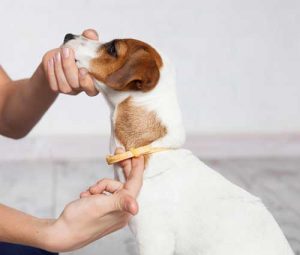
Carefully fit the collar around your dog’s neck making sure that it is not too tight or too loose. You should be able to slip two fingers between the collar and your dog's neck, like you see in the picture.
Make sure to wash your hands thoroughly with soap and hot water after touching the flea prevention collar. These collars contain concentrated ingredients that can be harmful if ingested.
Monitor your pet for any reactions to his flea prevention collar if this is the first time he is wearing one or the first time wearing a particular brand. Reactions to flea prevention collars are similar to those of other flea prevention reactions, but like shampoos, they tend to be more dermatological.
Monitor the collar as your pup wears it to ensure that it does not become too loose. A loose collar can be lost or can be chewed on by the dog and result in severe illness. Remember to change the flea collar as regularly as suggested by the manufacturer to ensure that it continues to work at preventing fleas on dogs.
RELATED REVIEW: Amber Crown Natural Flea and Tick Collars for Dogs
Natural and Homeopathic Dog Flea Preventatives
Talk to your vet about the safety and efficacy of the natural or homeopathic flea preventative that you are considering. Not all natural and homeopathic treatments are as harmless as they are purported to be, so it’s important to get a trained veterinarian to weigh in.
With clearance from your veterinarian, apply the natural or homeopathic flea preventative as directed. Monitor your pet for any signs of an allergic reaction. Just because something is “natural” does not mean that it cannot cause an allergic reaction for your dog – think of people who have food allergies!
Monitor your dog for any evidence of fleas throughout your use of natural and homeopathic flea prevention methods. These types of preventatives tend not to be as potent as other methods of prevention, so it is important to watch closely for any evidence of a flea infestation.
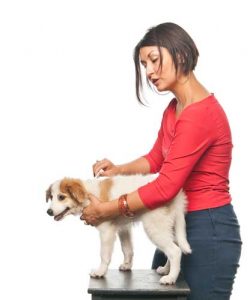 Reapply the natural and homeopathic flea prevention as directed. This can be as often as daily or as seldom as monthly, it really depends on the type of preventative that you are using.
Reapply the natural and homeopathic flea prevention as directed. This can be as often as daily or as seldom as monthly, it really depends on the type of preventative that you are using.
And Don’t Forget…
Dog flea preventatives are not 100% fail safe.
What does this mean for you? Even if you are vigilant in the application of flea preventatives, your dog may still contract fleas. This does not happen often, but if it does happen, it’s important to catch an infestation early so that you can prevent it from becoming too much of a problem. Make sure to get rid of any fleas in your home too, which can be easily done with carpet flea sprays or flea powders.
You should try running a flea comb over your dog to check for any signs of fleas or flea dirt on a regular basis. You should do this once a week as it will not only identify fleas, but it will also help you to identify any other parasites or growths on your dog’s skin.
READ NEXT: 9 Natural Home Remedies for Dog's Fleas and Ticks



